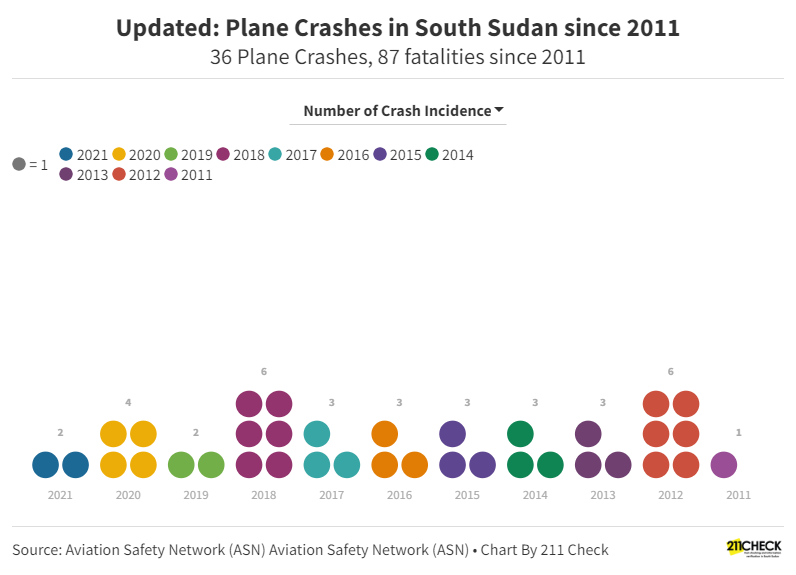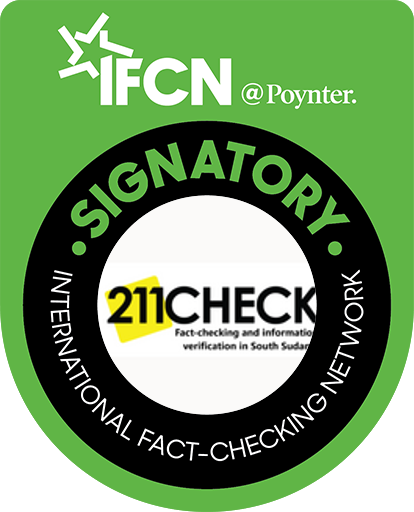Data Story: Plane Crashes in South Sudan; Number of Incidents and Fatalities since 2011
36 Plane Crashes, 87 fatalities since 2011
Updated by Justine Anthony
According to data obtained from the Aviation Safety Network, at least 87 people have died in various plane crashes since South Sudan’s independence from Sudan in 2011.
The biggest incident that claimed 41 lives occurred on November 4, 2015, near Juba International Airport in Central Equatoria State, when Allied Services Limited – lsf Asia Airways crashed while taking off.
The second biggest fatality occurred on September 9, 2018, near Yirol airstrip in Lakes State, when South West Aviation, lsf Slav-Air crashed while landing – a heartbreaking occurrence that killed 20 people, including a bishop.
Other recent crashes that killed several people include the recent South Supreme Airlines Pieri and last year’s South West Aviation incidents, which killed ten and seven people, respectively.
According to the data presented above, Central Equatoria State, Juba City, had the highest number of incidents that claimed several lives.
Wau Airport took second place among the airstrips that had several incidents, despite the fact that the number of passengers killed was lower.
According to the data, only a few people survived all of the crashes. However, the majority of the occurrences were unintentional. There were no instances of hijacking or criminal activity in any of the cases.
IATA neglected call
The International Air Transport Association encouraged South Sudan’s Civil Aviation Authorities in a letter dated February 8, 2021, to ensure that the desired level of safety and efficiency is implemented in the lower airspace.
Many interventions, according to the association, have not resulted in a clear improvement in safety performance.
Furthermore, the aviation body claimed that Juba is a difficult operational environment due to the following reported deficiencies:
- Air Traffic Services.
- Industrial action by civilian air traffic service personnel.
- Deployment of military air traffic controllers to replace civilian personnel.
- RNAV/GNSS approach procedures are deficient. Previous procedures were cancelled and are no longer valid.
- Frequency congestion as a result of combined Ground, Tower and Approach control services on a single frequency.
IATA recommended that airlines operating within the South Sudan Airspace at a minimum should:
- Treat the operation as specialized, and continue to exercise robust risk management practices pertaining to the operation.
- Ensure crews are well briefed of the above challenges.
- Operators should continue reporting issues/concerns in the above airspace using safety reporting mechanisms and, where applicable, the IATA GADM IDX program.
However, the appeal appears to have been in vain, or authorities may be carrying it out undercover.
About the Authors:
Justin Anthony, a Data Speaks Fellow at #defyhatenow South Sudan, updated this data story (already in the 211 Check archive), which was edited by 211 Check Editor Emmanuel Bida Thomas and approved for publication by Steve Topua, Data Analyst and Trainer. It’s part of the ongoing #defyhatenow South Sudan Data Speaks Fellowship program with funding from the European Union Delegation to South Sudan.
About South Sudan Data Speaks Fellowship:
This is a two-month and half data journalism fellowship for South Sudanese content creators with an aim of educating participants on the fundamentals of data journalism through in-depth training facilitated by experienced data analysts.
The fellows have been selected from across South Sudan and they are trained in data sourcing/mining, data analysis, and data visualization for two months and half (October to Mid December)
Each fellow will produce a minimum of three (03) data stories during the fellowship. The focus will be on increasing access to information

 211 Check
211 Check

Leave a Reply
Want to join the discussion?Feel free to contribute!